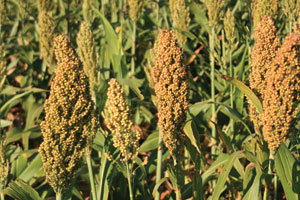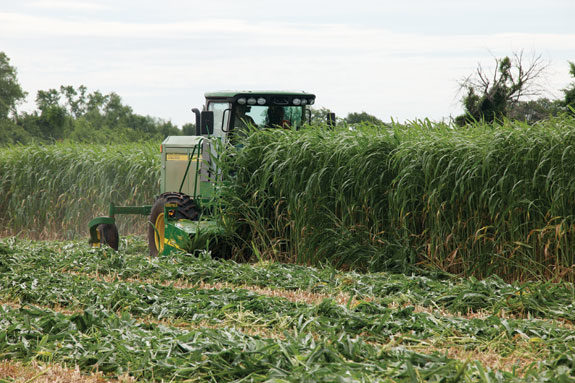Ten years ago, forage sorghum was not quite the popular choice that it is today. The Sorghum Checkoff is actively involved in research and promotion to enhance the potential of sorghum in the livestock market.
“Sorghum’s consistency of yield, low water consumption, and timeliness make it very versatile,” said forage sorghum producer and Sorghum Checkoff board member Dale Artho. “It produces high yields during hot summer months, requires minimal irrigation and provides a high-quality feed that is very palatable to cows.”
Research
Dr. Brent Bean, a researcher at the Texas AgriLife Research and Extension Center in Amarillo, Texas, has worked on many projects to improve forage sorghum. He studies forage sorghum for grazing, hay, silage and ethanol. Bean understands that sorghum is a great alternative to corn in regions where water is scarce.
“Corn is a good product, but we are running out of water in some areas. Sorghum gives farmers an option to produce a quality crop on 30 to 40 percent less water,” said Bean. “Plus, prices of corn seed are getting higher. Economically, sorghum is just cheaper to grow.”
The Bushland trials tested sorghum hybrids and experimental lines for agronomic characteristics such as water use efficiency, standability, forage and grain yield, and nutritional value.
“These trials have taught us a lot on which varieties to recommend for different situations,” Bean said.
The Bushland trials have seen great success with BMR varieties. Brown midrib (BMR) sorghums have been on the market since the late 1980s and were shown to contain less lignin, while maintaining a strong stalk that prevents lodging, or falling over. Lower lignin content means higher forage quality. In the last ten years, seed companies have brought many new and improved BMR sorghum and sorghum sudangrass varieties to the market.
“Several forage sorghum agronomic trials were conducted by Texas AgriLife Research and scientists at New Mexico State over the last ten years,” Bean said. “These trials recently led to a new forage sorghum production guide published by the United Sorghum Checkoff Program. This guide could be invaluable to silage producers who want to incorporate the latest technology in producing good quality, affordable silage.”

Nutrition
Studies have shown that dairy cows are likely to produce the same amount of milk when fed silages made from corn or BMR sorghum. Beef cattle are a similar example, as they gain the same amount of weight per day when fed sorghum or corn silage.
For this reason, many dairies include sorghum silage in their rations for dry cows, heifers and milk cows. At the same time, the sorghum industry is investing to further improve forage sorghum options.
“Today, the Sorghum Checkoff is working to improve traits like cold and drought tolerance. This would allow forage growers to plant earlier, allowing for a longer growing season and possibly multiple cuts,” Artho said.
Mark Marsalis, an Extension agronomist at New Mexico State University’s Agricultural Science Center in Clovis, New Mexcio, said the Bushland trials and those conducted at Clovis have helped increase knowledge about forage sorghum and the number of acres on which it is produced.
“Ten to 15 years ago we had very few acres of sorghum grown for silage in New Mexico. Now there are anywhere from 15,000 to 20,000 acres more in New Mexico,” said Marsalis. “The versatility of sorghum shows that you are able to market a quality silage product as water quantities decline. Under limited irrigation, sorghum has been known to produce as much or more tonnage than corn.”
Marsalis said that harvesting forage sorghum at the right time is critical in producing quality silage. The soft dough stage is typically the best time to harvest, but the moisture content varies so much at this stage it is best to look at total plant moisture. Moisture content should be between 65 and 70 percent at harvest to produce optimal silage.
From a nutrition standpoint, Marsalis said that BMR sorghum varieties are comparable to corn, and even better in some cases. Conventional sorghums are a little lower in nutrient value, but there are exceptions to every rule. BMR, though a high-quality forage, has been shown to yield a little less.
“Sorghum is a good fit in many situations, but it may not work for every farmer,” Marsalis said. “As water quantities continue to diminish, you will see sorghum play more of a role. That’s where forage sorghum will come through for many farmers and dairymen.”
Economics
While sorghum is a water-sipping forage option in the Southwest, it’s simply the economically conscious choice in the north central region of the U.S., where water shortage is less of a problem.
Earnest Weaver, a sorghum producer from Dongola, Illinois, whose sorghum market is mainly made up of dairy farmers, said sorghum provides him an agronomic and economical advantage.
“Sorghum was not in our sights around here 10 to 15 years ago. Today, it’s very efficient, very digestible, and needs less water and fertilizer than corn,” Weaver said. “We are able to plant sorghum later because it likes the hot summer days. It can thrive in warmer environments and still produce quality silage. Sorghum grows a stalk in the summer heat that is very digestible and provides plenty of energy for milk cows.”
With cold-tolerant hybrids in the pipeline, northern states could see a real advantage in the next several years. Weaver said that cold-tolerant sorghum would allow producers in states like Minnesota and Wisconsin the opportunity to plant in cooler soils and produce forage sorghum for dairies in those areas.
“The Sorghum Checkoff is conducting research to allow sorghum producers to be more specialized in what we grow,” said Artho. “We grow sorghum to make the end product better and that is exactly what the checkoff is trying accomplish – to make sorghum the very best it can be, both grain and forage.” FG
The feeding guides mentioned in this article offer tips and methods to incorporate forage sorghum and grain sorghum into rations in the livestock industry. To request a copy of the guides, contact Sue Ann Claudon at sueann@sorghumcheckoff.com or call 817-291-3237.
PHOTOS
TOP: Improved traits would allow forage growers to plant earlier, possibly allowing for multiple cuts.
Bottom: Sorghum grows a stalk in the summer heat that is very digestible and provides plenty of energy. Photos courtesy of the United Sorghum Checkoff Program.










